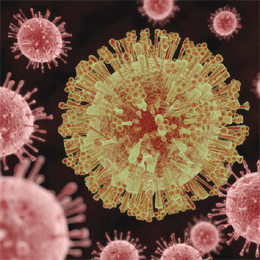
The virus has officially hit South Jersey, with cases turning up locally and in neighboring counties. While they’re mostly travel-related— since the Zika-carrying mosquitoes are not native to New Jersey—county leaders, health experts and the CDC are banding together for a concentrated fight to make sure an outbreak is not around the corner.
At first, news of the mosquito-borne Zika virus was just a distant fear, a concern in countries that felt far away in the Caribbean, Latin America, Africa and the Pacific Islands. As of April, the fear became local when a Camden County woman tested positive for Zika after traveling to a country where the virus-carrying mosquito is prevalent.
National headlines and coverage took flight as public health officials urged the country to be prepared for a possible outbreak in the United States, with the Centers for Disease Control and Prevention’s Dr. Anne Schuchat, principal deputy director, stating Zika “seems to be a bit scarier than we initially thought.” In a swift move, the Obama administration lobbied Congress with a $1.9 billion emergency fund, which was voted on in mid-May for $1.1 billion to combat the virus.
Yet, Zika is more than just a virus with flu-like symptoms. It could have the potential to cause Guillain-Barré syndrome (temporary paralysis) and it’s a serious threat for pregnant women, as it has a devastating effect on newborns and has been linked to a birth defect otherwise known as microcephaly—causing underdeveloped small brains and heads and other neurological disorders, ranging from mild to severe with the potential to be lifelong. Cases of babies born with the Zika-related birth defect have also been local, with the third U.S. baby born north of here at the Hackensack University Medical Center in early June.
Unfortunately, that number is rising and Zika cases have steadily grown in New Jersey with each passing week. As of June 30, there have been 44 reported cases of Zika in the state, with Burlington and Camden counties counting for eight of those cases.
As New Jersey residents face mosquito season—which typically runs from June to September depending on the climate—a time when travel plans tend to go abroad, destination weddings kick in, trips to the Shore become frequent and children spend time outside at camps, the fear of Zika is all too real. Today, the question becomes, how do we fight a virus that’s mosquito-borne?
The carriers
While scientists have found two potential vaccine candidates that are still in the testing phase, there are steps of prevention, which the CDC, federal government and county leaders are employing to help protect residents.
First and foremost, it’s important for residents to understand that currently there have been no local transmissions of Zika in the continental United States, according to New Jersey Department of Health spokesperson Dawn Thomas, nor do they expect widespread local transmission to take place.
“If transmission occurs in the United States, it would likely be small and limited in scope, based on experiences with chikungunya and dengue. To date, there have been no reports of Zika spread by mosquitoes in the continental United States, but nearly 700 cases have been reported in travelers,” Thomas says.
On a smaller scale, local county leaders strongly emphasize most cases have been associated with travel to countries where the Zika-carrying mosquitoes thrive—meaning the flying culprits, otherwise known as Aedes aegypti (yellow fever mosquito) and Aedes albopictus (Asian tiger mosquito), are not native to our region.
As Dr. Peter Bosak, superintendent of Cape May County’s Department of Mosquito Control, explains, the yellow fever mosquito is “the most effective by far” in terms of transmitting Zika and “it’s a major tropical subtropical species and does not normally occur in New Jersey. Even if it did, we have not seen it in New Jersey in a general way for probably about 10-15 years.”
As for the Asian tiger mosquito, it’s a more temperate mosquito and can survive our winters. “By nature, they are a bit more of a forest-type species.While it has adapted to being around people and it does feed on people, it’s not quite as aggressive and strongly associated with people the way the yellow fever mosquito is,” says Bosak before warning, “That’s not to say it isn’t a problem in New Jersey.”
Unfortunately, it’s possible through a number of routes—like someone’s suitcase or car traveling from a tropical climate or as larvae “in some sort of aquatic situation”—that the two vectors can make their way to our area. “We’ve been making sure we’re staying on top of that,” says Camden County Freeholder Carmen Rodriguez, who is also the liaison to the Camden County Department of Health and Human Services. “[We’re] making sure we monitor the phone calls [coming] in complaining about mosquitoes in [a resident’s] environment so that we can fumigate or treat.”
Both Bosak and Rodriguez stress these calls from residents can drastically help curtail mosquitoes propagating in our local areas. “If people are experiencing levels of mosquitoes that really make it uncomfortable to be outside, then that’s what we are here for,” advises Bosak. “They should report [it] so we have documentation to bolster our ability to possibly spray for those mosquitoes.”
Another means of mosquito prevention is removing any and all stagnant water— a mosquito’s breeding ground—from a property. As Bosak explains, both Zika-carrying mosquitos are considered “container-inhabiting mosquitoes” in that “they lay their eggs in containers that are either natural or artificial.” Those artificial containers come in the form of “bottles, buckets, tarps, sandboxes, small ponds that don’t have fish in them—anything you could possibly think of that could hold a little bit of water, will be a place where those mosquitoes’ larvae will be found.
“That is one of the biggest problems, because it makes it really difficult for people like us to control them,” adds Bosak. “We can’t literally go to everyone’s backyard and turn over every container. ... That’s why we’re constantly telling people to empty containers once a week around their homes so they can prevent the cycle of mosquitoes going through egg to larva to adult.”
As a means of statewide prevention, county mosquito control agencies have been working in tandem with the New Jersey Department of Health, the Department of Environmental Protection and the Mosquito Control Commission to ramp up their surveillance to monitor populations. “This is something that’s always done,” explains Rodriguez. “It’s been in operation for a very long time and it’s all the counties throughout the state in collaboration with the federal government.”
Those local agencies have also deployed inspectors responding to complaints and educating residents as well as implementing water management programs to remove problem areas that produce a lot of mosquitoes. Pesticides—both biological and larvae-eating fish, including fathead minnows, banded killifish and mosquitofish—have been introduced to kill larvae, while targeted adult mosquito spraying is done to control potential transmission.
Yet, with all of these means of prevention, there continue to be some unknown facts that are currently being researched—specifically if a mosquito can transfer the virus after biting a Zika-infected person. “The main vector is the yellow fever mosquito ... we know the Asian tiger mosquito can carry the Zika virus and it’s been found in many other species of mosquito, but the presence of the virus doesn’t necessarily mean that that mosquito is capable of transmitting that virus,” explains Bosak.
“Some mosquitoes are just better at transmitting viruses than others, and this is the same thing that happened with West Nile virus. We just don’t know enough about how well it can do that.”
Health risks
Preventing Zika-carrying mosquitoes from populating on a local level is a necessary precaution; however, the current risk is far greater for both pregnant women and travelers— especially in New Jersey, whose population is more than 20 percent foreign-born.
“Our biggest concern is that people who are traveling could potentially bring back the Zika virus,” says Rodriguez. “We don’t have the mosquito yet, but we can get the mosquito, so we want to make sure that we are always vigilant of what’s happening, but we’re also aware that it can actually be transmitted sexually.”
New findings from the CDC state men diagnosed with the Zika virus can sexually transmit the disease. There is, of course, a time frame in which it is unsafe for a couple to have unprotected sex. “We recommend they not have relations for eight weeks [and] if they’re with a man who is in an area that could potentially be exposed [to Zika], they should wait at least eight weeks,” explains Kennedy Health Chief Patient Safety and Quality Officer Dr. David V. Condoluci. “If a man had Zika, they should wait six months and use precaution like a condom because there has been potential transmission with semen in a man who is infected.
“The greatest risk is for the woman. The [symptoms for a] man and woman not of childbearing age [include] joint pain, a fever, rash, redness of eyes, but generally they will get well and not have any complications,” says Condoluci, who is also an infectious diseases specialist. “The biggest one is the risk to the pregnant woman in the first trimester and then there’s a small risk in others.”
As Condoluci explains, the first trimester is when the fetus is most susceptible to microcephaly since it’s when the central nervous system— including the brain and spinal cord— is developing. “If you do get exposed at the end of your pregnancy, chances of having a deformed child at that point [are] much lower than if you have it in the first weeks of pregnancy,” he states. “That’s not to say that you couldn’t have some problems in the second trimester, but the biggest risk is in the first 12 weeks.”
As science begins to tell us more about Zika, the CDC has learned breast milk is fortunately not affected by Zika, as there has been no evidence or reports that suggest otherwise. Furthermore, the CDC believes the virus will not pose a birth defect risk to future pregnancies once it leaves the woman’s system. Just like any other virus, once a person has been infected with Zika, they’re most likely protected from a future infection.
Experts also agree sexual transmission is still uncommon as compared to mosquito-related transmission. With that, women of child-bearing age or women who are pregnant are continuously urged to avoid traveling to Zika-prone countries. “I would avoid going to an area where there’s Zika, it’s not worth the risk,” says Condoluci. “If they’re going to an area where Zika is present, like to the Olympics [in Rio], they should be very careful.”
If, however, travel is unavoidable, Condoluci advises an immediate ER visit if symptoms present themselves. “If the story sounds right that you’ve been exposed, then you could get blood samples sent to the state and they would send them to a reference lab. ... Once you’ve got [Zika], there really isn’t anything you can do to treat it; you just have to ride it out. That’s why the best thing is to prevent it.”
Prevention
Aside from mosquito are being informed about Zika via the CDC and their respective Department of Health offices to better approach cases.
“Situational awareness briefs/updates are used as a key guide,” says Gloucester County Freeholder and liaison to the Gloucester County Department of Health and Human Services Jim Jefferson. “Health care providers are aware of formalized protocols established for Zika testing as approved by the New Jersey Department of Health.”
What’s more, the “department staff and local health partners also traveled to Atlanta in April to attend CDC’s Zika Action Plan Summit, where more than 300 local, state and federal officials, health experts and other partners collaborated to ensure a coordinated Zika response,” according to N.J. Department of Health spokesperson Thomas.
Awareness has also been raised in our neighborhoods, what with Camden County releasing a fact pamphlet in early June, Burlington County distributing door hanger fact sheets and Gloucester County offering requested public educational and awareness sessions and presentations. Local camps have also undergone educational protocol, as they’re currently in the thick of the summer season.
“Camps [were] educated on how to reduce standing water and potential mosquito breeding sites. Inspectors [helped] camp staff identify potential breeding areas and environmental concerns at the time of the pre-inspection,” explains Camden County’s Rodriguez.
“We are encouraging camp counselors and parents to protect children from mosquito bites by wearing long sleeves and long pants when possible or at dusk and dawn, when mosquitoes are more active,” she adds. “Adults should help children apply EPA-registered insect repellent to exposed skin, like those containing DEET, picaridin or oil of lemon eucalyptus.” Those preventative measures can also be applied to adults and pregnant women, per manufacturer’s instructions.
Burlington County Public Information Officer Eric Arpert echoes Rodriguez’s call for awareness, stating, “A major piece of our mosquito fighting approach is education ... and making residents aware of how they can best help to prevent the spread of mosquito and mosquito-borne illness.”
In light of that, New Jersey Commissioner of the Department of Health Cathleen D. Bennett launched the #ZapZika State Health Department public education campaign in March in hopes of educating about “the risk of the Zika virus to pregnant women, health care providers and those considering travel to Latin America and the Caribbean” via public events, NJ Transit bus advertising and radio public service announcements.
Another layer of prevention is the establishment of local Zika testing in Trenton. As of May 22, CDC-developed Zika tests, which “detect the virus and differentiate it from similar illnesses” are now completed at the New Jersey Public Health and Environmental Laboratories (PHEL) in collaboration with the CDC and New York State Health Department’s Wadsworth Center laboratory.
PHEL has only recently established a team of 22 members—including physicians, subject matter experts, technical personnel, regulatory and operations experts—to “plan and implement the tasks, tests and processes necessary for N.J. laboratory Zika testing response.”
Per Bennett, “The ability to test residents for Zika and similar viruses will further enhance New Jersey’s preparedness and response to this evolving health emergency unfolding in the Caribbean and Central and South Americas. We continue working every day to prevent local transmission as mosquito season approaches in New Jersey.”
With all of these preventative practices currently in place, the key to fighting Zika is ultimately education and awareness. “It is a little scary, but it’s important that people are aware,” says Rodriguez. “One of the biggest concerns the CDC has right now is too many people are not paying attention to Zika. Everyone is kind of brushing it off. ... It needs to be taken a little bit more seriously than what we are doing right now. I hate to put fear in people—and truly we’re in a good place at the moment—but sometimes the best way to keep it that way is just make sure you’re aware of actions you need to take to keep it that way.”
Published (and copyrighted) in South Jersey Magazine, Volume 13, Issue 14 (July, 2016).
For more info on South Jersey Magazine, click here.
To subscribe to South Jersey Magazine, click here.
To advertise in South Jersey Magazine, click here.












